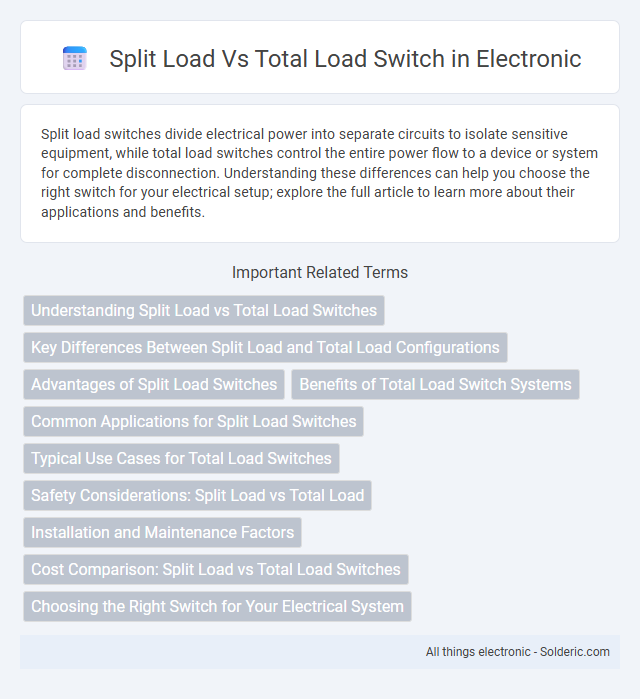Split load switches divide electrical power into separate circuits to isolate sensitive equipment, while total load switches control the entire power flow to a device or system for complete disconnection. Understanding these differences can help you choose the right switch for your electrical setup; explore the full article to learn more about their applications and benefits.
Comparison Table
| Feature | Split Load Switch | Total Load Switch |
|---|---|---|
| Load Connection | Divides load between multiple paths | Controls entire load on a single path |
| Application | Used in circuits requiring separate control of different load parts | Used to switch the complete load on/off |
| Complexity | More complex wiring and control | Simpler design and operation |
| Switching Speed | Generally slower due to multiple contacts | Faster switching with single contact |
| Fault Isolation | Better fault isolation because of split paths | Less fault isolation; entire load affected |
| Cost | Usually higher due to complexity | Lower cost and easier maintenance |
Understanding Split Load vs Total Load Switches
Split load switches separate power between different circuits, allowing independent control and enhanced safety by isolating specific sections of an electrical system. Total load switches control the entire power supply to a device or panel, enabling full isolation for maintenance or emergency shutdowns. Selecting between split load and total load switches depends on the desired operational flexibility and safety requirements of the electrical installation.
Key Differences Between Split Load and Total Load Configurations
Split load configurations distribute electrical current between multiple circuits, enhancing circuit protection and reducing overload risks, while total load switches manage the entire current through a single circuit, offering simplified control and maintenance. Split load switches provide increased safety by isolating faults to specific sections, whereas total load switches handle full circuit shutoff, simplifying emergency disconnections. Your choice depends on whether targeted protection or streamlined system management is the priority in your electrical setup.
Advantages of Split Load Switches
Split load switches offer enhanced control by isolating electrical circuits, reducing the risk of power interruptions affecting the entire system. They improve safety through selective disconnection, allowing maintenance or troubleshooting on one circuit without impacting others. Your electrical setup benefits from increased reliability and easier fault management due to this segmented approach.
Benefits of Total Load Switch Systems
Total load switch systems provide enhanced efficiency by managing power distribution uniformly across all circuits, minimizing energy losses and reducing operational complexity. These systems enable centralized control, improving system reliability and simplifying maintenance through fewer components and streamlined wiring. The ability to handle higher current capacities and offer better protection against overloads makes total load switch systems advantageous for large-scale electrical installations.
Common Applications for Split Load Switches
Split load switches are commonly used in residential electrical panels to separately control and protect lighting and outlet circuits, enhancing safety and convenience. Industrial settings utilize split load switches to manage machinery and auxiliary equipment independently, minimizing downtime and improving maintenance efficiency. You benefit from precise circuit isolation in these applications, ensuring reliable operation and simplified troubleshooting.
Typical Use Cases for Total Load Switches
Total load switches are commonly used in power distribution systems to control the main power supply to various devices or subsystems, ensuring safe and efficient load management. They are ideal for applications in battery-operated devices, portable electronics, and power management modules where complete power isolation is crucial. These switches simplify circuit design by providing a single point of control for turning off power during faults or maintenance, enhancing device reliability and safety.
Safety Considerations: Split Load vs Total Load
Split load switches enhance safety by isolating specific circuits, reducing the risk of overloads and allowing targeted maintenance without shutting down the entire system. Total load switches provide comprehensive disconnection, ensuring full power shutdown in emergencies but may cause broader service interruptions. When managing Your electrical system, choosing between split load and total load switches impacts both operational safety and maintenance flexibility.
Installation and Maintenance Factors
Split load switches require separate wiring for each load, simplifying troubleshooting and reducing the risk of total system failure during maintenance, whereas total load switches manage all loads through a single circuit, leading to easier initial installation but potentially more complex repairs. Maintenance of split load switches often involves isolating and servicing individual circuits without disrupting the entire system, enhancing safety and minimizing downtime. Total load switches can be more cost-effective initially, but maintenance may demand full system shutdowns, increasing operational interruptions.
Cost Comparison: Split Load vs Total Load Switches
Split load switches generally have a lower initial cost compared to total load switches due to their simpler design and selective load distribution features. Total load switches provide comprehensive power control but often come with higher manufacturing and installation expenses, reflecting their enhanced durability and broader application capacity. Cost efficiency in split load switches makes them ideal for segmented circuit management, while total load switches justify their investment with robust performance in full-load scenarios.
Choosing the Right Switch for Your Electrical System
Choosing the right switch for your electrical system depends on the specific load requirements and circuit design. A split load switch separates circuits, allowing independent control and enhanced safety for different loads, while a total load switch manages the entire electrical load through one control point, simplifying operation but reducing flexibility. Evaluating factors such as load type, control needs, and safety standards ensures optimal switch selection for efficient and reliable electrical system management.
split load vs total load switch Infographic

 solderic.com
solderic.com